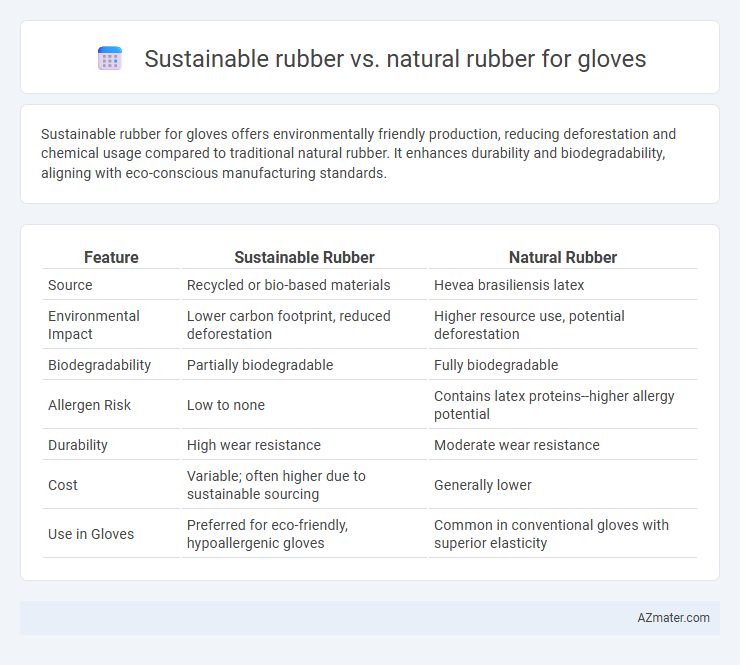Sustainable rubber for gloves offers environmentally friendly production, reducing deforestation and chemical usage compared to traditional natural rubber. It enhances durability and biodegradability, aligning with eco-conscious manufacturing standards.
Table of Comparison
| Feature | Sustainable Rubber | Natural Rubber |
|---|---|---|
| Source | Recycled or bio-based materials | Hevea brasiliensis latex |
| Environmental Impact | Lower carbon footprint, reduced deforestation | Higher resource use, potential deforestation |
| Biodegradability | Partially biodegradable | Fully biodegradable |
| Allergen Risk | Low to none | Contains latex proteins--higher allergy potential |
| Durability | High wear resistance | Moderate wear resistance |
| Cost | Variable; often higher due to sustainable sourcing | Generally lower |
| Use in Gloves | Preferred for eco-friendly, hypoallergenic gloves | Common in conventional gloves with superior elasticity |
Introduction to Rubber Types in Glove Manufacturing
Sustainable rubber in glove manufacturing is derived from eco-friendly sources and processed with reduced environmental impact, promoting responsible resource management. Natural rubber, traditionally sourced from Hevea brasiliensis latex, offers excellent elasticity and durability but poses challenges related to deforestation and biodiversity loss. Advancements in sustainable rubber production aim to balance performance with environmental stewardship, making it a viable alternative for eco-conscious glove manufacturers.
What is Natural Rubber?
Natural rubber is a biodegradable material derived from the latex sap of rubber trees, primarily Hevea brasiliensis, widely used in glove manufacturing for its excellent elasticity, tensile strength, and barrier properties. Sustainable rubber refers to natural rubber produced through environmentally and socially responsible practices, minimizing deforestation, reducing carbon footprints, and promoting fair labor conditions in rubber plantations. Choosing sustainable rubber helps maintain ecosystem balance while ensuring high-quality glove performance in medical and industrial applications.
Understanding Sustainable Rubber
Sustainable rubber for gloves involves sourcing latex from rubber trees managed under eco-friendly practices that minimize deforestation and promote biodiversity, ensuring long-term environmental balance. This approach includes certifications such as FSC or Rainforest Alliance, which verify sustainable harvesting, reducing chemical use and improving soil health compared to conventional natural rubber production. Sustainable rubber not only supports ethical labor conditions but also enhances glove quality by maintaining consistent latex purity and durability.
Environmental Impact: Sustainable vs Natural Rubber
Sustainable rubber production reduces deforestation and promotes biodiversity by implementing eco-friendly harvesting methods and certified plantations, significantly lowering environmental degradation compared to conventional natural rubber. Natural rubber extraction often involves extensive land clearing and monoculture plantations, leading to habitat loss and increased carbon emissions. Sustainable rubber initiatives prioritize soil health, water conservation, and reduced chemical use, resulting in a more environmentally responsible alternative for glove manufacturing.
Ethical Considerations in Rubber Sourcing
Sustainable rubber sourcing for gloves emphasizes fair labor practices, minimizing environmental impact, and ensuring transparent supply chains, addressing common ethical concerns linked to natural rubber harvesting. Natural rubber often involves challenges such as worker exploitation, deforestation, and biodiversity loss, prompting a shift toward certified sustainable rubber standards like FSC or Rainforest Alliance. Ethical considerations in rubber sourcing influence consumer trust and corporate responsibility in the glove manufacturing industry.
Comparative Performance: Glove Quality and Durability
Sustainable rubber gloves offer comparable tensile strength and elasticity to natural rubber gloves, ensuring reliable fit and comfort during extended use. In durability tests, sustainable rubber exhibits enhanced resistance to wear and environmental degradation, prolonging glove lifespan under demanding conditions. Both materials maintain essential barrier properties, but sustainable rubber reduces ecological impact without compromising glove quality.
Health and Safety Implications
Sustainable rubber gloves reduce exposure to harmful chemicals like accelerators and allergens commonly found in natural rubber, minimizing risks of skin irritation and allergic reactions among healthcare workers. Enhanced production processes of sustainable rubber emphasize lower allergenic protein content, improving overall biocompatibility and user safety. These gloves also support long-term occupational health by promoting safer material sourcing and reducing the environmental footprint associated with traditional natural rubber cultivation.
Cost Analysis: Sustainable vs Natural Rubber Gloves
Sustainable rubber gloves generally incur higher initial costs due to eco-friendly harvesting and processing methods compared to natural rubber gloves, which benefit from established supply chains and lower production expenses. However, long-term cost benefits arise from sustainable rubber gloves through reduced environmental impact fees, improved compliance with green regulations, and potential market premiums. Analyzing lifecycle cost expenses reveals that sustainable rubber gloves may offer greater economic value over time despite higher upfront investments.
Future Trends in Rubber Glove Production
Sustainable rubber in glove production emphasizes eco-friendly harvesting methods and reduced carbon footprint compared to traditional natural rubber, addressing environmental concerns within the medical and industrial sectors. Innovations in sustainable rubber sourcing and processing are expected to enhance glove durability and biodegradability, meeting increasing regulatory and consumer demands for greener products. Future trends indicate a shift towards integrating blockchain for supply chain transparency and adopting renewable energy in manufacturing to bolster the sustainability credentials of rubber gloves.
Choosing the Right Rubber for Glove Manufacturing
Sustainable rubber offers an eco-friendly alternative to natural rubber by promoting responsible harvesting practices and reducing environmental impact in glove manufacturing. Choosing the right rubber involves evaluating factors such as durability, elasticity, and allergen content, with sustainable rubber often providing comparable performance to natural rubber while supporting social and environmental sustainability. Manufacturers prioritize sustainable rubber to meet regulatory standards and consumer demand for greener, safer gloves.

Infographic: Sustainable rubber vs Natural rubber for Glove
 azmater.com
azmater.com